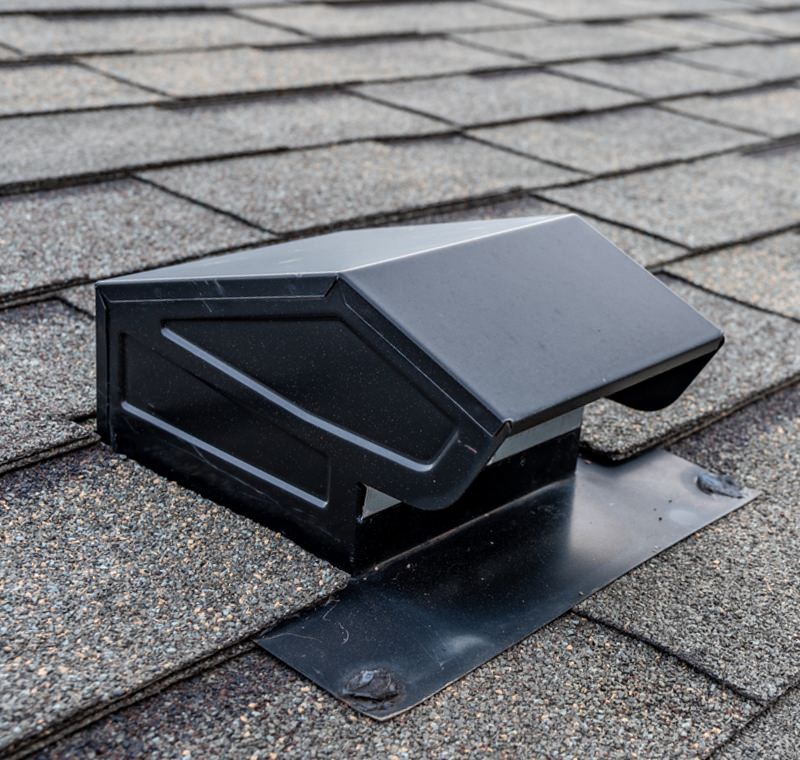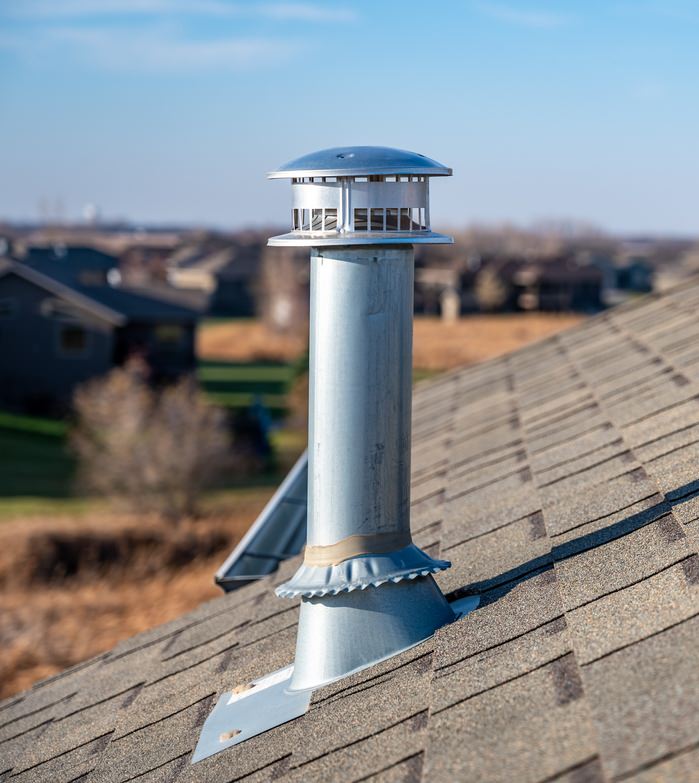FAQ’s About Roof Ventilation Systems
Posted on Sunday, July 23rd, 2023 | 1,634 views
 This FAQ answers questions about roof ventilation systems, and roof repairs with an overview of what the system is and how it works in your home. While reading this article remember that you need to be very cautious when working on a roof — especially at heights — and never try any tasks that you are not comfortable with.
This FAQ answers questions about roof ventilation systems, and roof repairs with an overview of what the system is and how it works in your home. While reading this article remember that you need to be very cautious when working on a roof — especially at heights — and never try any tasks that you are not comfortable with.
Answer to Questions about Roof Ventilation Systems
Are all roof ventilation systems built the same?
No. The desired result of every roof ventilation system is to ventilate the attic and help properly regulate the temperature in the home but each ventilation system set up can be different depending on the builder and type of roof installed.
Here are a the most popular types of roof ventilation systems:
- Box/low profile vents.
- Wind turbines/whirlybirds.
- Power vents/PAVs.
- Ridge vents.
- Soffit vents.
- Gable vents.
- Cupola vents.
The type of ventilation a roof needs depends on the roof design, climate, attic size, and roofing materials used.
How long does a typical roof ventilation system work properly?
A typical roof ventilation system can work properly between 15 to 25 years, but this can depend on the quality of the system, the climate, and the amount of maintenance it gets. Some systems like those with mechanical or electrical components usually require parts to be replaced more frequently.
What are the signs that my roof ventilation system is damaged?
Signs that your roof ventilation system is damaged can include:
- moisture or condensation in the attic.
- a noticeable difference in indoor and outdoor temperatures.
- mold or mildew growth.
- ice dams forming at the roof’s edge in the winter.
- unusually high energy bills.
- the roof is deteriorating prematurely.
If my roof ventilation system is blocked what can I do?
If your roof ventilation system has some sort of blockage preventing its performance, you or a service provider has to identify and remove the obstruction. The obstruction could be as simple as debri like leaves or bird nests, but if the blockage is more severe you’ll need to hire a professional.
Items that can clog a roof ventilation system include:
- Leaves and twigs.
- Dust and dirt.
- Bird nests and other animal debris.
- Mold and mildew.
- Old roofing materials.
- Snow and ice.
- Old attic insulation.
Can a damaged roof ventilation system damage my roof or attic?
 Yes. If the roof ventilation system is damage or clogged, it could end up damaging your roof or attic due to poor ventilation. It can also lead to moisture buildup which tends to cause wood rot, floods, and structural damage. The damage can also lead to the formation of winter ice dams that cause leaks and further erode the integrity of the roof system.
Yes. If the roof ventilation system is damage or clogged, it could end up damaging your roof or attic due to poor ventilation. It can also lead to moisture buildup which tends to cause wood rot, floods, and structural damage. The damage can also lead to the formation of winter ice dams that cause leaks and further erode the integrity of the roof system.
This is how the most popular air vent systems fail:
- Box vents: These vents can become clogged with leaves, dust, or nests made by small animals and birds. They can also get damaged by extreme weather or physical impact.
- Wind turbines: These are susceptible to clogs and mechanical failure. If the moving parts are inhibited, it can prevent the turbine from spinning. Wind turbine bearings also wear out over time and start hindering movement.
- Power vents: Power vents are susceptible to electrical and mechanical failures from dust and debris which can clog the fan blades and reduce efficiency. If the motor burns out, the entire system fails.
- Soffit vents: These are often located on the low end of the roof and easily get clogged with dust, debris, or wildlife. They’re also susceptible to being blocked from the inside during the installation of attic insulation.
- Ridge vents: Ridge vents can get clogged with dust or snow, and get damaged by high winds.
- Gable vents: These can get clogged with dust and debris, and damaged by weather conditions or physical impact, Because of their size they may also allow pests to enter.
Can a damaged roof ventilation system be repaired or replaced?
Usually a roof’s ventilation system can be fixed if it’s been damaged to any degree. This obviously depends on the nature and extent of the damage but because it’s built into the roof, repairs are usually all that is necessary.
Issues like a blocked vent can be repaired relatively easily but more severe damage or systemic issues may require a full replacement so it’s always best to consult with a professional roofer before making any decisions.
How much does it cost to replace a damaged roof ventilation system?
The cost will vary depending on the extent of the damage and the type of system that was built. Small repairs might cost a few hundred dollars while replacing an entire system or the roof could cost several thousand.
We advise you to always get a detailed estimate from a reputable roofing contractor before proceeding with any work.
Can I fix a roof ventilation system myself or should I hire a professional?
You can fix the problem if it’s minor like removing an obstruction, but if the system is damaged due to more serious reasons, you have to consult with a roofing company. You need to make sure any work is done correctly and more importantly ensure the ventilation system is working as it should be.
If your roof is damaged in any of the following ways, you should hire a professional roofer:
- Structural damage such as torn, missing, broken or deformed turbines or vents.
- Electrical issues that need professional’s attention.
- Major blockages lik large nests, snow or ice accumulation, large insect infestations or beehives.
- Poor air circulation indicate a more complex issue that a professional should handle.
- Water leaks due to poorly installed or damaged vents.
- Pest infestation need a professional to safely remove the them and repair any resulting damage.
- Improper installation where a professional roofer must diagnose and correct installation problems.
- Need for an upgrade if your current system isn’t sufficient and needs more effective ventilation.
You probably don’t need to have your roof reinstalled but you can read this article for detailed information on what to expect in a roof replacement if it eventually needs to be done.
How often should I have my roof ventilation system inspected and maintained?
 It’s a good practice to have it inspected at least once every 3 to 5 years. Usually after 5 years, you’ll be able to identify any building flaws that may start to cause issues, or see signs the system is failing or wasn’t installed properly.
It’s a good practice to have it inspected at least once every 3 to 5 years. Usually after 5 years, you’ll be able to identify any building flaws that may start to cause issues, or see signs the system is failing or wasn’t installed properly.
This is especially true if you live in an area with severe weather and should include regular maintenance, like removing debris and checking for damage which will keep your system in good condition and extend its lifespan.
If your roof ventilation system needs to be fixed, you probably want to know if there’s a roofer in Burlington that actually fixes them.
Do Roofers Fix Roof Ventilation Issues?
Most professional roofers do fix roof ventilation systems but other tradespeople may also need to be involved depending on the specific issue and the type of system that was installed.
For example if the issue is due to electrical or wiring problems, an electrician may need to be involved. If the problem is due to the structure or framing of the roof, a carpenter may be needed. In some cases a specialized contractor or technician may be need to address certain issues related to solar-powered or mechanical systems.
Ultimately a reputable roofing company knows the appropriate course of action to take and will help you as required.
Issues when roofers are generally not involved in roof ventilation repairs:
- Electrical wiring for powered ventilation systems.
- Advanced HVAC system installations.
- Pest infestations in vents or attic.
- Air quality issues and testing.
- Mold remediation within the ventilation system.
- Soundproofing associated with roof ventilation systems.
- Fire safety systems linked to roof ventilation.
- Maintenance for solar-powered ventilation systems.
If You Think Your Roof Ventilation System is Failing
If you really believe your roof ventilation is failing, consult with a professional as soon as possible. Ignoring a failing system can and does lead to more expensive problems down the road and can also become a major safety hazard.
Read More...
 Desi's Roofing has been providing high quality roofing services in Burlington since 1959 on a foundation of quality work and customer service. We publish these articles in order to help our customers and casual readers to get the most out of their roof and learn to manage and maintain it over the years.
Desi's Roofing has been providing high quality roofing services in Burlington since 1959 on a foundation of quality work and customer service. We publish these articles in order to help our customers and casual readers to get the most out of their roof and learn to manage and maintain it over the years.
If there is a particular subject you'd like us to write about feel free to contact us at 905-319-0880 anytime.
Leave a Reply